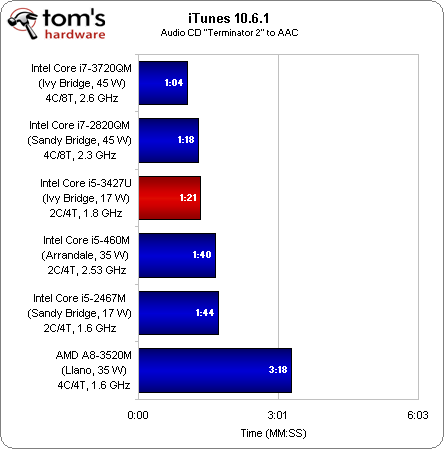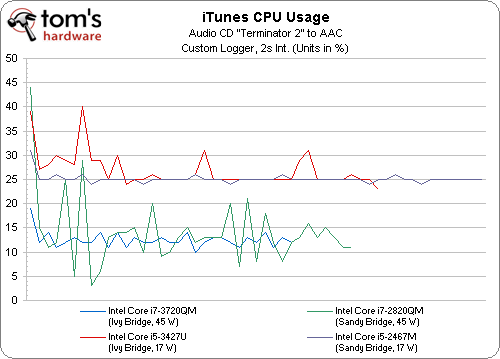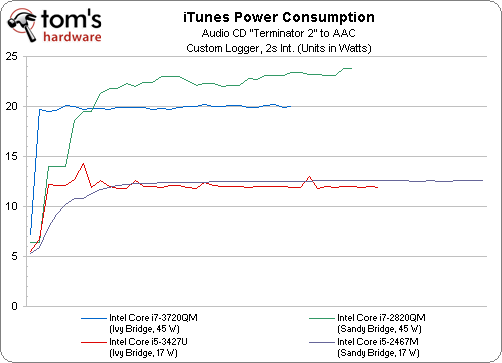Second-Generation Ultrabooks: Faster And Cheaper With Ivy Bridge
Benchmark Results: iTunes
Our single-threaded iTunes workload gives us a nice contrast to Photoshop and WinRAR, since it allows each CPU to hit its highest Turbo Boost frequency and strut the virtues of its respective architecture.
Because it accelerates to a higher clock rate and enjoys better instruction-per-cycle throughput, the Core i5-3427U in our second-gen Ultrabook cruises past the Core i5-2467M in our older machine. Both 45 W parts turn in even more impressive results, though the Core i7-2820QM isn't that much faster than the Ivy Bridge-based part under the microscope today.
Because iTunes' AAC conversion only uses one thread at a time, we can't tax any of these machines using it. The Ivy Bridge-based Core i7-3720QM spins up a single core, but it exploits as much available TDP as possible to reach 3.6 GHz. In comparison, last-generation's Core i7-2820QM touches 3.4 GHz. But because its power consumption spikes slightly higher, it isn't as efficient.
The 17 W Core i5s exhibit similar CPU utilization, but the Ivy Bridge-based -3427U demonstrates a power consumption advantage. A peak Turbo Boost clock of 2.8 GHz allows the newer chip to get its job faster within the same power envelope as the older model, which tops out at 2.3 GHz.
Get Tom's Hardware's best news and in-depth reviews, straight to your inbox.
Current page: Benchmark Results: iTunes
Prev Page Benchmark Results: WinRAR Next Page Benchmark Results: Battlefield 3-
sam_fisher It seems that Ivy Bridge's lower TDP and its HD 4000 comes into its own in the notebook/ultrabook market more so than the PC/gaming one.Reply -
sam_fisher crisan_tiberiuthey should use HD 4000 on every intel CPU, i dont get it why they dont ...Reply
The integrated graphics is built into the processor die and the changes between the HD 3000 and 4000 are physical changes, so they can't just change them without changing the whole CPU.
-
mayankleoboy1 crisan_tiberiuthey should use HD 4000 on every intel CPU, i dont get it why they dont ...Reply
Pricing, TDP, segmentation and PROFIT -
crisan_tiberiu sam_fisherThe integrated graphics is built into the processor die and the changes between the HD 3000 and 4000 are physical changes, so they can't just change them without changing the whole CPU. Yes, i know that :)) but when they designed IVY they should have designed every chip with the HD 4000. The HD 4000 is still outperformed by Liano iGPU if you remember...Reply -
tomfreak Cant u put an older/previous generation desktop and benchmark against it? I cant or couldnt get how a fast a 2.0GHz Ivy vs a similar Nehelem Desktop CPU vs desktop core 2 duo CPU. Many of us buy notebook to replace desktop for casual use, we would like to know what it can do vs our old desktop.Reply
Besides get some older AAA games to bench, nobody play BF3 at Ultra books with HD4000. We wanna see what old games we can max out @ full resolution. -
silverblue I think AMD missed a trick with Llano. Instead of throwing four lowly clocked cores at a mobile processor, perhaps two higher clocked cores would've made much more sense. That way, they could possibly sport a higher clock GPU as well within the same TDP.Reply
Trinity's lower powered, higher clocked cores already look to have partly made up for this, but until the 17W variant comes along, there's no real indication of how it'll measure up to IB ULV. However, we do know that AMD pairs the slower GPUs with the slower CPUs and vice versa, so there's little chance of a, say, 2C/2T/1M CPU with the 7660G GPU. -
DjEaZy ... ok... you compare the Llano to Sandy/Ivy bridge in CPU performance, but not in GPU performance? and why not Sandy/Ivy Bridge to Trinity?Reply
... and Adobe Photoshop CS 5? not CS 6?


